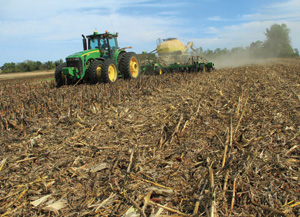 By Mark Loux, OSU
By Mark Loux, OSU
Herbicide options for burndown of existing weeds prior to planting of no-till wheat include glyphosate, Gramoxone, Sharpen, and dicamba. Among these, the combination of glyphosate and Sharpen probably provides the best combination of efficacy on marestail, flexibility in application timing, and residual control. Dicamba labels have the following restriction on preplant applications – “allow 10 days between application and planting for each 0.25 lb ai/A used”. A rate of 0.5 lb ai/A would therefore need to be applied at least 20 days before planting. We do not know of any 2,4-D product labels that support the use of 2,4-D prior to or at the time wheat planting. There is some risk of stand reduction and injury to wheat from applications of 2,4-D too close to the time of planting. Liberty and other glufosinate products are also not labeled for use as a burndown treatment for wheat. Sharpen should provide limited residual control of winter annuals that emerge after herbicide application, and the rate can be increased from 1 to 2 oz/A to improve the length of residual. Gramoxone should also effectively control small seedlings of marestail and other winter annuals. Be sure to use the appropriate adjuvants with any of these, and increase spray volume to 15 to 20 GPA to ensure adequate coverage with Sharpen or Gramoxone.
There are several effective postemergence herbicide treatments for wheat that can be applied in November to control these weeds, in fields where preplant burndown treatments are not used. The most effective postemergence treatments include Huskie, Quelex, or mixtures of dicamba with either Peak, tribenuron (Express, etc), or a tribenuron/thifensulfuron premix (Harmony Xtra, etc). We discourage the application of 2,4-D to emerged wheat in the fall due to the risk of injury and yield reduction.
 LONDON, Ohio – More than 50 companies will join the ranks as exhibitors for the 61st Farm Science Review Sept. 19-21 at the Molly Caren Agricultural Center. The new exhibitors represent various sectors in the agriculture industry including livestock handling, equipment advancements, agronomic technology, agricultural policy, and more.
LONDON, Ohio – More than 50 companies will join the ranks as exhibitors for the 61st Farm Science Review Sept. 19-21 at the Molly Caren Agricultural Center. The new exhibitors represent various sectors in the agriculture industry including livestock handling, equipment advancements, agronomic technology, agricultural policy, and more.
 Join the Digital Ag Team as they dive into research results from around the state of Ohio based on the 2021 eFields report. Registration is free but required. Have you been enjoying the 2021 fields Report and are excited to learn more? Join us to learn more about the eFields program and the results we are seeing across the state.
Join the Digital Ag Team as they dive into research results from around the state of Ohio based on the 2021 eFields report. Registration is free but required. Have you been enjoying the 2021 fields Report and are excited to learn more? Join us to learn more about the eFields program and the results we are seeing across the state.

 lication for the 2021 Ohio Wheat Performance Trials has been finalized and is attached as a PDF file. This article will be published in the mid-August issue of the Ohio Country Journal. All of these results are also available online at the wheat performance trials website:
lication for the 2021 Ohio Wheat Performance Trials has been finalized and is attached as a PDF file. This article will be published in the mid-August issue of the Ohio Country Journal. All of these results are also available online at the wheat performance trials website:  By Jason Hartschuh, OSU Extension Educator, Crawford County
By Jason Hartschuh, OSU Extension Educator, Crawford County
 By Mark Loux, OSU
By Mark Loux, OSU
 Yield results for the 2020 Ohio Wheat Performance Test are online at
Yield results for the 2020 Ohio Wheat Performance Test are online at 

